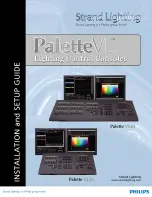
11
Any position between the two will blend Wet and Dry signal to the outputs.
DELAY TIME
- Sets the length of Delay from the
BBD
delay line based
on the Range switch setting. In Flange Mode, with
AMOUNT
set to 0, the
Delay Time changes from .6 msec to 10 msec nominal. In Chorus mode this
change is 5 msec to 50 msec nominal.
RANGE
- Sets the range of delay times available to the
DELAY TIME
control.
Flange selects a range of shorter delay times while Chorus selects a range
of slightly longer delay times.
FEEDBACK
- Sets the amount of
BBD
output fed back into the input of the
BBDs
. In Flange Mode, this is used to increase the sharpness and intensity
of peaks in the frequency response of the comb filter. Both Positive and
Negative Feedback are available, with zero feedback at mid-position.
In Flange Mode, Positive Feedback emphasizes all the harmonics of
a fundamental frequency equal to the inverse of the Delay Time – For
instance 10 msec Delay creates a comb filter with a fundamental frequency
of 100 Hz and emphasis at 200 Hz, 300 Hz, 400 Hz, 500 Hz, etc. Negative
Feedback shifts the frequency response spectrum down by one octave
which causes only odd harmonics to be emphasized. For instance, a 10
msec Delay Time with negative feedback creates a comb filter with a
fundamental frequency of 50 Hz and harmonic emphasis at 150 Hz, 250 Hz,
350 Hz, 450 Hz, etc.
In Chorus mode, because the Delay Time is usually longer than the time
period of the fundamental frequency of the input signal, the difference in
tone between positive and negative feedback is much less noticeable.
WARNING:
The Cluster Flux Feedback control is designed to drive the
delay line into self-oscillation. This means the Cluster Flux is capable of
producing a tone without any audio signal present.
Tones produced by
self-oscillating feedback may be much stronger than normal signal levels,
so watch your speakers and ears.
Oscillation typically begins at the 4th indicator lines both left and right
of the Feedback control’s mid position.
LFO WAVEFORM
- Selects the LFO waveform for modulation of the Delay
Time. There are six waveforms available: Sine, Triangle, Square, Sawtooth,
Ramp and Random Stepped waveforms. Note that with LFO Amount at
zero, no modulation will be heard.
LFO RATE
- Sets the frequency of modulation of the Delay line by the LFO.
The Rate can be varied from .05 Hz to about 50 Hz. The LFO Rate LED
indicates both the rate and waveform of the current LFO settings. The LED
is
RED
when the Rate is set from the front panel,
GREEN
when the rate
is set by the Tap Tempo switch, and
YELLOW
when the LFO is synced to
MIDI clock. When synced to MIDI clock, the Rate control is quantized to
select only rhythmic subdivisions of the MIDI Clock tempo.






































